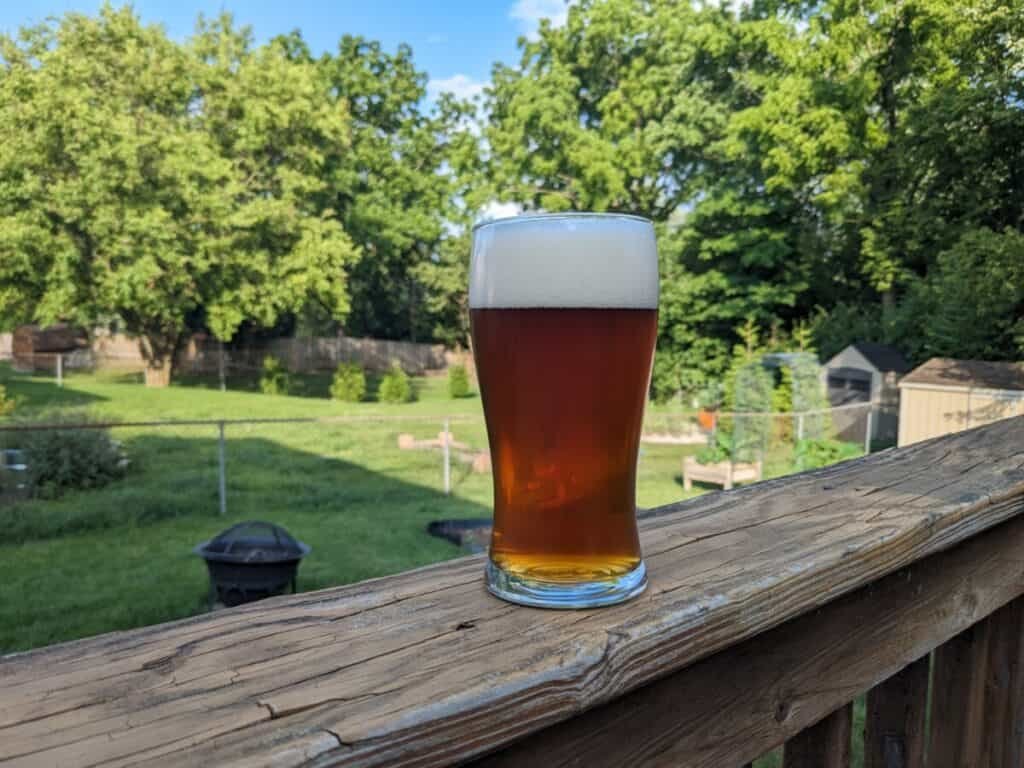American Amber Ale
What is American Amber Ale? According to the BJCP guidelines (2021), it is “an amber, hoppy, moderate-strength American craft beer with a malty caramel flavor. The balance can vary quite a bit, with some versions being fairly malty and others being aggressively hoppy. Hoppy and bitter versions should not have clashing flavors with the caramel malt profile.”
| BJCP Category | 19A |
| ABV | 4.5–6.2% |
| Original Gravity (OG) | 1.045–1.060 |
| Final Gravity (FG) | 1.010–1.015 |
| IBU | 25–40 |
| Color (EBC) | 19.7–33.5 |
The first two amber ales I remember having were New Belgium’s Fat Tire and Bell’s Amber Ale. Beers that were easy-drinking and could be enjoyed year-round.
I’ve brewed a few different amber ales that I’ve thoroughly enjoyed. For this brew, though, I decided to try a recipe from the one and only David Heath. His style guide and his tried-and-tested recipe can be found here.
One Way to Brew an American Amber Ale
I modified his recipe with ingredients that were available to me, as well as to my homebrewing set-up. The link to the recipe I brewed can be found here.
Learn more about the grain-to-glass process on our YouTube channel:
Batch Vital Stats
| Stat | Value |
|---|---|
| OG | 1.057 |
| FG | 1.015 |
| ABV | 5.5% |
| Color | 26.5 EBC (calculated by Brewfather) |
| IBU | 35 |
| Boil Time | 30 minutes |
| Batch Volume | 21 L |
Recipe
Water Profile
| Ca2+ (ppm) | Mg2+ (ppm) | Na+ (ppm) | Cl– (ppm) | SO42- (ppm) | HCO3– (ppm) | pH |
|---|---|---|---|---|---|---|
| 100 | 15 | 37 | 76 | 187 | 81 | 5.36 |
To reach the target water profile, I added half of a Campden tablet, 3.3 g calcium chloride, 1.9 g magnesium sulfate, 3.3 g calcium sulfate, and 2 mL lactic acid to my source water. After 10 minutes into the mash, I took an aliquot and cooled the sample to 16 °C. The pH measured 5.36.
Fermentables
| % | kg | lb | Grain/Adjunct |
|---|---|---|---|
| 80 | 3.872 | 8.536 | Thomas Fawcett Maris Otter |
| 10 | 0.484 | 1.067 | BestMalz Munich |
| 5 | 0.242 | 0.5 | Great Western Crystal 2-row (148 EBC) |
| 4 | 0.194 | 0.428 | Briess Victory Malt |
| 1 | 0.048 | 0.1 | Briess Roasted Barley |
Mash Profile
| Step | Temperature (°C) | Temperature (°F) | Time (minutes) |
|---|---|---|---|
| Saccharification Rest | 67 | 153 | 60 |
| Mash-out | 75 | 167 | 10 |
Hops
| Hop | Alpha Acid | Time | IBU |
|---|---|---|---|
| Magnum | 14.0% | 30 minutes | 15.2 |
| Centennial | 7.4% | 15 minutes | 7.8 |
| Amarillo | 7.6% | 15 minutes | 7.5 |
| Centennial | 7.4% | Hopstand @ 80 °C, 10 minutes | 2.2 |
| Amarillo | 7.6% | Hopstand @ 80 °C, 10 minutes | 2.1 |
Yeast
For this recipe, I used Voss Kveik from Lallemand. The wort was chilled to 35 °C and transferred to a Kegland Fermzilla All Rounder 30L fermenter.
Fermentation Profile
| Step | Temperature (°C) | Temperature (°F) | Time/% of Fermentation |
|---|---|---|---|
| Primary | 35 | 95 | 7 days |
Fermentation temperature was maintained between 31 to 35 °C using a seedling heat mat and an insulated jacket over the fermenter. Fermentation was complete after 3 days, however, I left the beer for 7 days before transferring it to a keg.
Final gravity (FG) was 1.015, which gives 5.5% ABV and an attenuation of 73%. The final pH was 4.36 (16 °C).

Conditioning and Carbonation
After transferring the beer to a keg, I added gelatin for clarity. The keg was pressurized and kept at 12 psi CO2 at a temperature of 5 °C for 2 weeks.
| Step | ||
|---|---|---|
| Conditioning | 5 °C/41 °F | 14 days |
| Carbonation | 12 psi | 2.4 volumes of CO2 |
Recipe Impressions
With initial pouring, there is a small amount of chill haze that disappears once the beer reaches about 8 °C. There is a fluffy white head that persists throughout the entire drinking session, leaving a bit of lacing.


The aroma that comes through is a bit of orange and grapefruit with a touch of freshly baked bread. Mouthfeel is fairly smooth with a medium body. In the flavor, I get a bit of caramel sweetness and toasted bread. The hops leave enough bitterness to cut down some of the sweetness. As for hop flavor, I get orange, grapefruit, and a bit of pine in the background.
Overall, this is a nice, refreshing amber ale that I think would taste great during a tailgate in late summer/early autumn.
Do you enjoy amber ales? If so, let me know in the comments!
